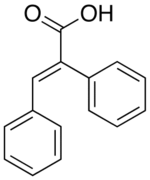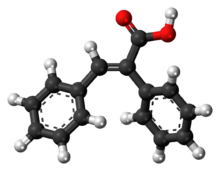Chemistry:Alpha-Phenylcinnamic acid

| |

| |
| Names | |
|---|---|
| Preferred IUPAC name
(2E)-2,3-Diphenylprop-2-enoic acid | |
| Other names
α-Phenylcinnamic acid, α-(Phenylmethylene)benzeneacetic acid, α-Phenyl-trans-cinnamic acid
| |
| Identifiers | |
3D model (JSmol)
|
|
| ChemSpider | |
| EC Number |
|
PubChem CID
|
|
| UNII | |
| |
| |
| Properties | |
| C15H12O2 | |
| Molar mass | 224.259 g·mol−1 |
| Appearance | White to light yellow powder |
| Melting point | 172 to 174 °C (342 to 345 °F; 445 to 447 K) |
| Boiling point | 224 to 225 °C (435 to 437 °F; 497 to 498 K) |
| Slightly soluble | |
| Hazards | |
| Main hazards | Irritant[1] |
| GHS pictograms | 
|
| GHS Signal word | Warning |
| H315, H319, H335 | |
| P261, P264, P271, P280, P302+352, P304+340, P305+351+338, P312, P321, P332+313, P337+313, P362, P403+233, P405, P501 | |
Except where otherwise noted, data are given for materials in their standard state (at 25 °C [77 °F], 100 kPa). | |
| Infobox references | |
α-Phenylcinnamic acid is a phenylpropanoid, or, more specifically, a derivative of cinnamic acid. It has the formula C15H12O2 and appears as an off-white crystalline solid.[2]
Uses
α-Phenylcinnamic acid is frequently used as a compound synthesized in undergraduate laboratories to study the Perkin reaction, but is primarily seen as in intermediate or precursor to other, more useful phenylpropanoids.
Synthesis
There are many ways to synthesize α-phenylcinnamic acid. Some of the more popular methods of formation include the condensation of phenacyl chloride with benzaldehyde in the presence of triethylamine, the distillation of benzylmandelic acid, or by the reaction of sodium phenylacetate with benzaldehyde in acetic anhydride.[3] There are two isomers of this compound, differing in the geometry of the alkene. The E isomer, in which the two phenyl rings are cis to each other, is the major product formed by most synthetic routes. However, this compound can be converted using heat or ultraviolet light into a mixture containing nearly 50% of the Z isomer.[4] Decarboxylation of α-phenylcinnamic acid yields stilbene, with the (E) isomer producing cis-stilbene and the (Z)-isomer producing trans-stilbene.[5]
References
- ↑ http://msds.chem.ox.ac.uk/PH/alpha-phenyl_cinnamic_acid.html [|permanent dead link|dead link}}]
- ↑ "ChemExper". http://www.chemexper.com/search/cas/91485.html.
- ↑ Organic Syntheses, Coll. Vol. 4, p.777 (1963); Vol. 33, p.70 (1953).Link
- ↑ "Experimental and Computational Tools for Mechanistic Study: A Modified Perkin Condensation leading to Alpha-Phenylcinnamic Acid Isomers". Electronic Conferences on Trends in Organic Chemistry: ECTOC-1: June 12-July 7, 1995. http://www.ch.ic.ac.uk/ectoc/papers/45/ECTCIN.html.
- ↑ Buckles, Robert E.; Wheeler, Norris G. (1953). "cis-Stilbene". Organic Syntheses 33: 88. doi:10.15227/orgsyn.033.0088. http://www.orgsyn.org/demo.aspx?prep=CV4P0857.; Collective Volume, 4, pp. 857
 |

